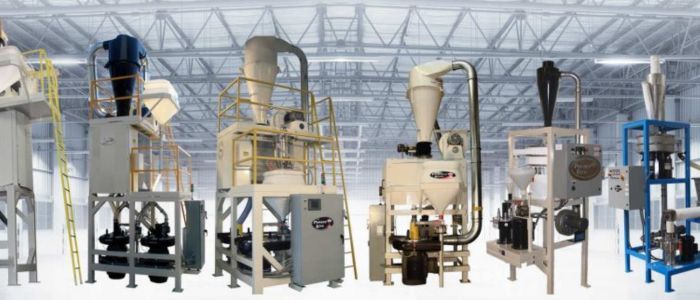Green is the New Black: Why the GGRF Matters to Your Small Business
What if you could significantly reduce your operating costs? Then imagine if you could attract a new wave of environmentally

By Corey Rockafeler

Small business owners need to be adaptable. Smart financial decisions are needed to stay competitive. One such decision involves obtaining the right equipment to thrive in an evolving market. However, purchasing equipment can often pose a challenge due to the high upfront costs involved.
Fortunately, where there are obstacles there are also opportunities. Is there a cost solution available? Absolutely! Let's explore the realm of used equipment financing, which can be a game changer for businesses aiming to expand without breaking the bank.
Used equipment financing presents an opportunity for small businesses to acquire the machinery and tools they need for growth and expansion. Whether you require cutting-edge computers, heavy machinery or commercial vehicles utilizing used or owned equipment financing options could be the key to unlocking your success.
The Advantages of Asset Based Lending
When it comes to financing used equipment, asset-based lending (ABL) is an accessible funding approach tailored to businesses. Unlike bank loans that often have eligibility criteria and lengthy approval processes, ABL utilizes the value of your existing assets as collateral. The innovative method allows you to secure funds quickly, allowing you to acquire equipment without wasting time.
Embracing the Benefits of Used Equipment
One of the attractions of used equipment financing is cost savings. Used machinery is available at a fraction of the price of equipment, allowing you to allocate resources towards critical aspects of your business. Moreover, opting for used equipment contributes to sustainability efforts by extending machinery lifespan.
Navigating the Market for Used Equipment
In the realm of used equipment there are options available catering to all types of businesses. Whether you require office equipment, construction machinery, restaurant appliances or medical devices, there are choices at your disposal.
For many small businesses used equipment financing emerges as a game changer. There are numerous benefits and advantages. With a simplified application process and flexibility in equipment options this option becomes quite appealing to businesses looking for opportunities to expand.
In the following sections we will explore the ins and outs of financing used equipment. We will also explore the process of qualifying for it and how you can make informed choices to secure the funds. Stay tuned as we uncover the secret to unlocking growth with this financing solution.

Used equipment financing extends beyond just getting the necessary equipment. It is a tool with a big impact on your company's success. Let's examine this financing option in more detail so you can choose wisely for your company.
Choosing used equipment over new equipment has advantages. Besides saving you money, it allows you to manage your money better. Investing in used equipment can free up your capital for other crucial aspects of your business. This includes marketing initiatives, employee training, and expanding your product line.
Furthermore, used equipment has already proven its reliability and durability. You'll have peace of mind knowing you're making a smart investment that will last.
Used Equipment Types
In the used equipment market, there is a plethora of choices to suit industries and businesses. Whether you're managing a tech startup, a manufacturing facility, or a restaurant you'll discover a selection of equipment options tailored to your requirements.
Small businesses commonly finance all types of used equipment such as office furniture and electronics, construction machinery, agricultural devices, healthcare equipment and transportation vehicles. The wide range of options guarantees something for every niche in the business world.
The Importance of Asset Based Lending (ABL)
Used equipment financing is built on asset-based lending, which sets it apart from other types of lending. ABL considers your current assets, including inventory, accounts receivable, and real estate as collateral instead of just relying on credit scores and cash flow.
Businesses with poor credit histories or little operational experience can still get the funds thanks to this strategy that emphasizes assets. Asset-based lending offers flexibility, making it an appealing option for businesses looking for a flexible financing solution.
If you decide to finance used equipment, there are risks to consider. If you want to avoid unexpected maintenance costs, it's essential to assess the equipment's condition and its remaining lifespan.
With proper due diligence, these risks can be managed. It's important to partner with a reputable asset-based lender that can help you avoid pitfalls and find real growth opportunities.

To be eligible to finance used equipment there are criteria to meet. By gaining an understanding of the procedure and implementing measures you can ensure that your small business is well positioned to secure the necessary funding for your needs.
Creditworthiness and Collateral
Asset-based lending evaluates not only your business assets, but also your credit history. While the focus is on the assets, creditworthiness still matters. The collateral requirements will also depend on the type of equipment you want to finance. Equipment serves as collateral. However, additional assets may be required to fully secure the loan.
Established Business History
The age and track record of your business can influence your eligibility for used equipment financing. Lenders typically prefer businesses with a proven operating history, as it demonstrates stability and reliability.
This could be a challenge for startups or new businesses. Don't lose heart—some asset-based lenders are more lenient toward emerging businesses, assessing your application based on your potential rather than your past performance.
Cash Flow Considerations
While ABL focuses on assets as collateral, lenders may still evaluate your business's cash flow. A stable and positive cash flow indicates that your business can handle the financial obligations associated with the loan.
Lenders will want to ensure that your business can comfortably manage loan repayments without significant strain on its financial health. Presenting a well-structured cash flow projection can reinforce your application and increase your chances of approval.
Documentation and Transparency
As with any loan application, transparency is key. Providing accurate and comprehensive documentation showcases your commitment to responsible financial management. Prepare your financial statements, tax returns, and any relevant records related to the equipment you wish to finance.
Be prepared to answer any questions or provide further details as needed during the application process. Open communication with your lender fosters trust and demonstrates your dedication to obtaining the financing your small business requires.
Success Tips:
1. Start by conducting research on the equipment you need to gain a good understanding of its market value. This will help you determine the loan amount.
2. Create a crafted business plan that clearly outlines your goals, strategies and how acquiring the equipment will contribute to your overall success.
3. Reach out to an equipment financing expert who can offer guidance and support throughout the entire process.
4. Before submitting your loan application carefully review your credit report, for any inaccuracies or areas that can be improved upon.
5. When negotiating loan terms consider your business situation and align them with what would work best for you.

Applying
The application process for used equipment assistance is designed to be straightforward, effective, and provide businesses with a clear path to getting the funds they need. You can expedite the process by being well prepared and organized. Make your business more likely to obtain financing.
Research and Choose the Right Lender
The first step is to research and identify lenders experienced in used equipment financing. Look for institutions with a track record of catering to small businesses and a solid understanding of asset-based lending. Compare their loan terms, interest rates, and customer reviews to make an informed decision.
Gather Essential Documentation
Before submitting your application, compile all the necessary documentation. This typically includes financial statements, tax returns, business licenses, and any information related to the equipment you wish to finance. Being thorough and organized during this phase can speed up the approval process.
Present a Comprehensive Business Plan
A well-crafted business plan serves as the backbone of your application. Outline your business's status, future goals, and how the equipment acquisition will contribute to your growth strategy. A compelling business plan showcases your dedication and professionalism to potential lenders.
Submit the Application
After you have collected all the paperwork and completed your business plan it is now time to submit your application. Numerous lenders provide application alternatives, which further enhance the convenience and effectiveness of the process.
Review and Negotiate Loan Terms
Once you submit your application the lender will carefully review the information you provided. If your application meets their requirements, they will offer you loan terms and conditions. Make sure to go through these terms and don't hesitate to negotiate if necessary. Asset based lending offers the advantage of loan structures so take advantage of that opportunity.
Close the Deal and Secure the Funds
After reaching an agreement on the terms the next step is to complete the transaction and ensure the funds are secured. Typically, the lender will directly provide the funds to the equipment seller. It's crucial to understand the repayment schedule and be aware of the potential repercussions if you fail to meet your loan obligations.
Expert Tip: Don't Rush the Process
While used equipment financing offers a quicker and more accessible funding option, it's crucial not to rush through the application process. Take the time to thoroughly review the terms, ask questions, and seek professional advice if necessary. A well-planned and structured approach will ensure a smooth and successful financing experience.
There are several options for small business equipment. You can finance used equipment in a few ways. Your business goals and financial situation will guide your decision.
A. Used Equipment Financing vs. New Equipment Financing
Used Equipment Financing:
- Lower Upfront Costs: Opting for pre-owned equipment means reduced upfront expenses, freeing up capital for other business needs.
- Faster Acquisition: With less paperwork and quicker processing times, used equipment financing allows you to get the equipment you need promptly.
- Proven Performance: Used equipment often comes with a track record, providing insights into its reliability and performance.
New Equipment Financing:
- Stay Ahead with Advanced Technology; When you invest in equipment you gain access, to cutting edge technology and its latest features giving your business an edge.
- Secure Long-Term Investment; Opting for equipment ensures that you make a long-term investment in your business. With a lifespan it becomes a choice for businesses aiming for sustained growth.
- Added Protection, through Manufacturer's Warranty; New equipment comes with the added benefit of a manufacturer's warranty providing you with extra protection and peace of mind.
B. Used Equipment Financing vs. Leasing
Used Equipment Financing:
- Ownership: Financing used equipment allows you to own the assets outright, giving you full control and flexibility over their usage.
- Potential Equity Buildup: As you pay off the loan, you build equity in the equipment, which can be valuable for future financial decisions.
- Tax Benefits: Interest and depreciation expenses may be tax-deductible, offering potential tax advantages for your business.
Leasing:
- Lower Monthly Payments: Lease payments are typically lower than loan repayments, providing more immediate cash flow relief.
- Equipment Upgrade Options: Leasing allows you to upgrade to newer equipment at the end of the lease term, staying up-to-date with technology.
- No Ownership Responsibilities: The lessor is responsible for maintenance and repairs, relieving you of the burden of equipment upkeep.
C. Used Equipment Financing vs. Traditional Bank Loans
Used Equipment Financing:
- Easier Approval: ABL focuses on collateral rather than credit scores, making it more accessible to businesses with less-than-perfect credit.
- Faster Processing: Traditional bank loans may involve a lengthy approval process, while ABL offers quicker access to funds.
- Flexibility: Asset-based lending provides more flexibility in loan structures and repayment terms, tailored to suit your business needs.
Traditional Bank Loans:
- Established Relationships: If you have a long-standing relationship with a bank, it may result in favorable loan terms and conditions.
- Higher Loan Amounts: Depending on your creditworthiness, traditional bank loans may offer higher loan amounts for substantial equipment needs.
- Competitive Interest Rates: In some cases, established businesses with excellent credit can secure competitive interest rates on bank loans.
In the end, deciding between financing used equipment and other alternatives depends on your business's needs, financial condition, and growth goals. Small businesses can achieve success by considering the advantages and disadvantages of each option.

Selecting the right lender for your used equipment financing is crucial to ensure a smooth and successful financing experience. To make an informed decision and secure the best terms for your business, consider the following expert tips:
1. Expertise in Asset-Based Lending (ABL)
Look for lenders with a proven track record in asset-based lending, particularly in the equipment financing niche. A lender experienced in ABL will have a better understanding of the specific challenges and opportunities that come with financing used equipment for small businesses.
2. Customer Reviews and References
Research customer reviews and testimonials to gain insights into the lender's reputation and customer satisfaction. Additionally, don't hesitate to ask the lender for references from previous clients who have used their services for used equipment financing. Speaking directly with other small business owners can provide valuable perspectives.
3. Transparent and Clear Terms
Choose a lender that is upfront and transparent about their terms and conditions. Avoid lenders who use unclear language or impose hidden fees. You should have a clear understanding of the loan's interest rate, repayment schedule, and any potential penalties or fees.
4. Lender Flexibility
Look for a lender who's willing to collaborate with you and customize the loan to meet the specific needs of your business. A lender that offers loan structures can provide you with the best financing arrangement that aligns with your equipment requirements and financial situation.
5. Timely Communication
Maintaining communication is crucial throughout the financing process. It's important to select a lender who promptly responds to your inquiries and keeps you updated on the progress of your application. A lender who openly communicates and collaborates can foster a relationship built on trust and positivity.
6. Knowledge in Your Industry and Equipment
It's worth considering partnering with a lender who has expertise in financing equipment within your industry. Having experience, with the type of equipment you require can streamline the application process. Ensure a deeper understanding of your business equipment needs.
7. Pre Approval Opportunities
Certain financial institutions may provide the opportunity for pre-approval when it comes to financing used equipment. This allows you to have knowledge of the amount you can borrow and the specific terms that apply. Having pre-approval can give you an edge in negotiations with equipment sellers. It will streamline the overall financing process.
Used equipment financing presents a compelling solution for small businesses seeking cost-effective ways to acquire the machinery and tools they need. Its asset-based lending approach leverages your existing assets, making the application process more accessible and streamlined compared to traditional bank loans. This financing option offers benefits such as lower upfront costs, faster equipment acquisition, and the ability to own the equipment outright.
Choosing the right lender is critical to the success of your financing journey. We provided expert tips to help you navigate this decision, emphasizing the importance of expertise, transparency, and flexibility in loan structures. By partnering with the right lender, you can embark on a smooth and rewarding financing experience.
As you move forward, remember to conduct thorough research, seek professional advice, and stay open to negotiation. Armed with this knowledge, you are now equipped to take the next step towards securing the used equipment financing your business needs to thrive in today's competitive landscape.
Unlocking growth through used equipment financing is not just a financial transaction; it's an investment in the future of your small business. As you seize opportunities, make strategic decisions, and equip your business with the tools it needs, may this journey lead you to new heights of success and prosperity.
Here's to a future filled with growth, innovation, and achievement. The power to shape your business's destiny is now in your hands.
Sign up for the newsletter and get our latest stories delivered straight to your inbox.